'THE CAR OF COMFORT with the Reserve of Speed,' that was the slogan of the Moon Motor Car Company .of St Louis, and it certainly encapsulated their sales philosophy of offering the middle-class motorist a vehicle which tended to have ideas above its station, with better styling and performance than were normal in its price bracket.
The Moon company - headed by Joseph W. Moon, who had emigrated from Scotland - were builders of horse-drawn buggies before they turned to motor manufacture. Their first products, though, were a far cry from the buggies, as Moon engaged Louis P. Mooers as designer.
Moon Model A
Mooers had been designer with Peerless of Cleveland, Ohio, where he had produced some formidable racing cars, as well as refined touring cars; he was also a racing driver of some note. His first car for Moon was the Model A, a 30/35 hp model using a proprietary Rutenber engine with four cylinders, and the pre-war models were large, well-built cars of distinctive appearance.
Two four-cylinder cars, of 5.2 and 5.8 liters were available in 1912, joined by a six-cylinder model the following year. By 1916, there were only sixes, with 3.6 and 5-liter Continental power units, the marque soon acquiring an imitation Rolls-Royce radiator to head them.
Moons were soone being exported, mainly to the UK, where the agents were North Western Motors of Norton Street, Liverpool, who also handled the obscure Dixie Flyer from Louisville, Kentucky. At first, they imported the 3177 cc 6-42 23.6 hp six, which had overhead valves and Wagner electric lighting and starting, the five-seater tourer, painted Moon Blue and costing £575 complete with 'genuine tan Spanish upholstery'.
The design had retrogressed by 1922, the engine now had side valves, although the Moon touring car was now £25 cheaper, while 12 months later the Moon stand at Olympia was graced by the Stewart tourer, the Stanley Semi-Sports Four-Five Seater and the Sefton four-door, six-seat saloon. All had British-built coachwork, and the standard specification included speedometer, clock, licence holder, spring gaiters and tyres. The engine had pump cooling and forced lubrication, while the gearbox, built in unit, housed three speeds. The brakes worked on the rear wheels and transmission only.
North Western Motors were obviously hedging their bets, because in 1923 they were also offering the Roamer, which was another car equipped with an imitation Rolls radiator. It also had a Continental engine, a 5-liter six, although earlier versions of this 'superb production' had used Duesenberg or Rutenber engines. There was little difference in the styling or finish between Moon and Roamer, save that the Moon was cheaper!
Adopting Lockheed External Contracting Brakes All Round
Both cars had curious suspension features, with the Moon possibly winning on points, as it had quarter-elliptic front springs and three-quarter elliptics at the rear, while the Roamer was conventional at the front and double-cantilever sprung at the rear. In 1924, the Moon used Lockheed external contracting brakes all round, and was thus, with Chrysler, one of the American pioneers of this kind of braking system. The car also featured detachable disc wheels with detachable rims, which seemed to be too much of a good thing.
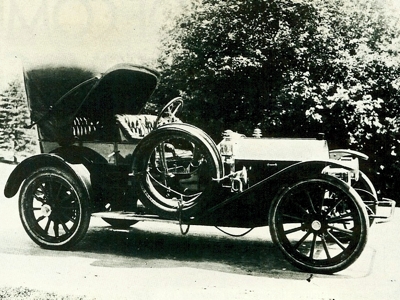 1910 Moon 35 hp tourer. It was designed by Louis P Mooers and featured a four-cylinder engine and shaft drive.
1910 Moon 35 hp tourer. It was designed by Louis P Mooers and featured a four-cylinder engine and shaft drive.
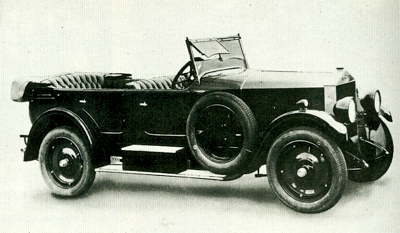 1920 20hp Moon powered by a six-cylinder Continental engine.
1920 20hp Moon powered by a six-cylinder Continental engine.
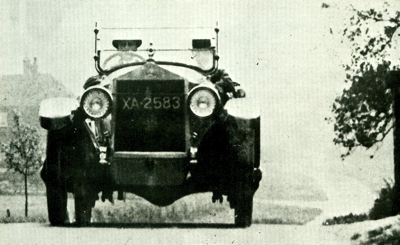 1921 Moon Tourer.
1921 Moon Tourer.
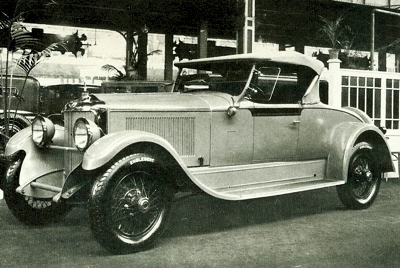 1923 Moon 6-60 de luxe roadster, powered by an in-line six cylinder Continental engine, which developed 47 bhp at 2600 rpm. It had a top speed of 80 mph.
1923 Moon 6-60 de luxe roadster, powered by an in-line six cylinder Continental engine, which developed 47 bhp at 2600 rpm. It had a top speed of 80 mph.
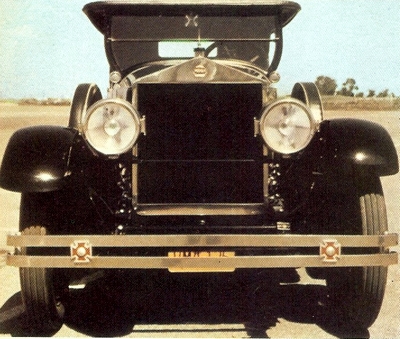 1923 Moon 6-58 Sport Phaeton, which used a 128 inch chassis.
1923 Moon 6-58 Sport Phaeton, which used a 128 inch chassis. |
The price of a new Moon continued to fall as production techniques improved, and the cars were soon fitted with automatic windscreen wipers, a windscreen anti-dazzle device and, on the saloon, a rear-view mirror, an item of equipment notably lacking on most cars of the era. Two-tone paint was also available. The sales blurb read ... 'While most announcements echo rising prices, the Moon gives you more quality, more distinction, more service and complete new features .. at lower prices. It fairly bristles with new features that every motorist will be eager to read about - and see. It has the newest four-wheel hydraulic brakes, and genuine big, flexible balloon tyres. Also a new steering mechanism specially designed for greater leverage - an absolute necessity for balloon-tyre driving. Every mechanical unit in the Moon is the latest authority in engineering practice.'
Diana The Moon Goddess
Also in 1925, the Moon acquired a sister marque, the Diana, whose shouldered radiator shell was similar to that of the
Belgian Minerva, and which bore on its cap a sculpture of Diana the moon goddess, with bow, arrow and dog (and not a stitch of clothing). It had a 4-liter straight-eight Continental engine with a Lanchester crankshaft vibration damper, and a chassis specification broadly similar to the Moon, except that it had wooden artillery wheels instead of solid disc wheels.
The Easiest Steering Car in America
The Diana could accelerate from 5 to 25 mph in 6.5 seconds, and had a top speed of over 70mph. The two-seater roadster was in the fashionable 'sporty' idiom, with a golf-bag locker behind the seats; one variant offered a bronzed. radiator shell with wire wheels plated to match. Its makers called the Diana 'the easiest steering car in America' although, as it had the same Ross steering as its stablemate, this claim was a little suspect.
However, the Diana only lasted from 1925 to 1928 before it was dropped, but the mock-Minerva radiator was also used on the 1927 Moon 6-60. The old. 23.6 hp model was dropped in 1926, after the British concessionaires had dropped prices in order to clear stocks. 'The most wonderful proposition ever made to the motoring public,' they called it, and then erupted in a riot of superlatives, 'The Moon is a real luxury car that gives true motoring relaxation. Beautiful of line and engineering efficiency epitomised. It will register 50 to 60 miles an hour for as long as you desire, yet withal it is particularly easy to handle in traffic. The wonderful Lockheed hydraulic four-wheel brakes are the last word in velvet braking, and the ease with which the, new patent multi-leverage steering mechanism enables one to park and un-park is truly remarkable:"
Moon 6-60 with Continental Red Seal Engine
Prices dropped at the beginning of 1927, but rose again by the end of the year. A new 6-60 was also released by the end of the year, which featured a 19.8 hp Continental Red Seal engine of 2.8 liters (which had only pump and splash lubrication). Also the ubiquitous Moon Blue color scheme was dropped, and the standard finish was now in Pyroxyline cellulose (the earlier model had used Dupont cellulose), with a color scheme of Cactus Grey below and between the belt and black above.
Closed models were upholstered in Velour Plush with 'extra deep cushions'. The car's power unit was uprated for 1928, to create a new model, the 6-72, which developed 66 bhp against the standard unit's 48; this was achieved by using a high-compression cylinder head. All Moon models now had a new design of radiator shell, this time very similar to that of the contemporary LaSalle, which was itself a crib of the Hispano-Suiza. Moons were now apparently being exported to Britain in chassis form only, as North .Western Motors were offering British-built coachwork along with British head, side and tail lamps.
The Moon Aerotype 4.4-liter
The range now consisted of a roadster, a coupe and a saloon, finished in Moon Blue Belco cellulose. With the dropping of the Diana, a straight-eight was marketed under the Moon name for the first time: this was the 1928 Aerotype 4.4-liter, which developed 85 bhp at 3100 rpm, using a high-compression side-valve power unit (again a Continental), with a twin-choke Stromberg Duplex carburetter.
In describing the new model, the Moon publicity department reached new heights of hyperbole: 'The Continental 15-5-engined eight has a high-nickeled radiator, a cowl surcingle of which the cowl lamps are integral parts, and nickeled headlamps are connected by a monogrammed bracket. A cadet-type windshield visor, long sweeping full-crowned fenders and a deep running board give the cars a very low appearance, the body lines are of French-Spanish appearance.'
The six-cylinder model was rechristened Aerotype, too, and now had Bohnalite Invar strut aluminum pistons and a Lanchester vibration damper on the crankshaft. Wire wheels were standardised throughout the range, and six-cylinder models had dampers on the front axle only, the eights having them front and rear.
The White Prince of Windsor
In 1929, Moon announced a new version of the straight-eight, with a double-dropped chassis frame which lowered the floor line by seven inches, and a four-speed 'twin-top' gearbox in place of the three-speed units of its predecessors. The Lockheed brakes were now internally expanding, and the chassis had fully automatic pressure lubrication of the springs and shackle bolts. The new Moon was known as the White Prince of Windsor, in honour of the Prince of Wales, and its double-dropped chassis was also used on the six, which had adjusting rubber-type spring shackles.
That year, Moon sold 2900 cars, but they also became embroiled with New Era Motors Incorporated, in which they were united with Gardner, Kissel and Ruxton. The Gardner was a dullish vehicle whose slogan 'A Distinctively Different Motor Car' was about as far from reality as it was possible to get; the Kissel had been a sporting marque of some distinction and the Ruxton was a bizarre rarity. Ruxton's history was complex: it had been the brainchild of Archie M. Andrews, a financier who was on the board of Hupp Motors. Andrews had named it after a friend, William v. C. Ruxton, who had shown enthusiasm for front-wheel drive, and who possibly seemed like a soft touch for a spot of extra capital.
The prototype Ruxton appeared in early 1929 and was hailed as being almost a foot lower than any other car of its day; it combined front-wheel drive with a rigid beam axle, and the power unit was a Continental straight-eight of 5.5 liters. Production began in mid 1930 in the Moon and Kissel factories and, although the Ruxton was sold as a high-priced luxury model, with prices ranging up to $5000 dollars, there was a curiously parsimonious look about the sedan versions. This was hardly surprising, as they were built by Budd using the same body dies as the British Wolseley.
Joseph Urban
However, if these bodies were dull outside, they were well appointed inside, with color schemes worked out by a leading stage designer named Joseph Urban, who even devised a livery of narrow horizontal rainbow bands for one car! The open bodies, on the other hand, were built by Raulang (who as Rauch & Lang had built electric cars from 1905 to 1908, latterly in the old Stevens-Duryea works at Chicopee Falls, Massachussets), and were strikingly handsome.
Twenty-five Ruxtons, which had such odd features as WoodIite parabolic headlamps and a gearlever projecting from the dashboard, were built in the Kissel factory (there was even talk of fitting one of the odd EIcar Lever engines into one of these Ruxtons, but it did not come to fruition). The rest - and production estimates of Ruxton output vary from 52 to 500 cars were built by Moon, using Kissel-manufactured transmissions. However, there were few sales for the Ruxton, and by 1931 New Era Motors was out of business, dragging Moon and Gardner down with it, while
Kissel lingered on a couple of years longer, reorganised by George A. Kissel as Kissel Industries, attempting to market a Ruxton-inspired car with a Lever engine. The Lever engine and the Ruxton front-wheel drive were mechanically incompatible, though, and the venture quietly died. As for Moon, the end was perhaps inevitable, there was not really a place for Iow-volume quality cars in the American car market of the 1930s. But one wonders whether the St Louis firm could have kept going through the Depression if it had not been saddled with the other lame ducks of the New Era Group.
